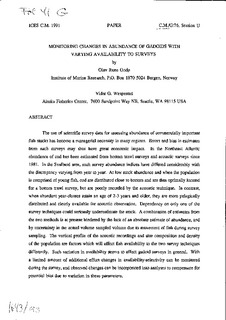Monitoring changes in abundance of gadoids with varying availability to surveys
Working paper
Permanent lenke
http://hdl.handle.net/11250/104902Utgivelsesdato
1991Metadata
Vis full innførselSamlinger
Originalversjon
This report is not to be cited without prior reference to the authorsSammendrag
The use of scientific survey data for assessing abundance of commercially important
fish stocks has become a managerial necessity in many regions. Errors and bias in estimates
from such surveys may thus have great economic impact. In the Northeast Atlantic
abundance of cod has been estimated from bottom trawl surveys and acoustic surveys since
1981. In the Svalbard area, such survey abundance indices have differed considerably with
the discrepancy varying, from year to year. At low stock abundance and when the population
is comprised of young fish, cod are distributed close to bottom and are thus optimally located
for a bottom trawl survey, but are poorly recorded by the acoustic technique. In contrast,
when abundant year-classes attain an age of 2-3 years and older, they are more pelagically
distributed and clearly available for acoustic observation. Dependency on only one of the
survey techniques could seriously underestimate the stock. A combination of estimates from
the two methods is at present hindered by the lack of an absolute estimate of abundance, and
by uncertainty in the actual volume sampled volume due to movement of fish during survey
sampling. The vertical profile of the acoustic recordings and size composition and density
of the population are factors which will affect fish availability to the two survey techniques
differently. Such variation in availability seems to affect gadoid surveys in general. With
a limited amount of additional effort changes in availability-selectivity can be monitored
during the survey, and observed changes can be incorporated into analyses to compensate for
potential bias due to variation in these parameters.
